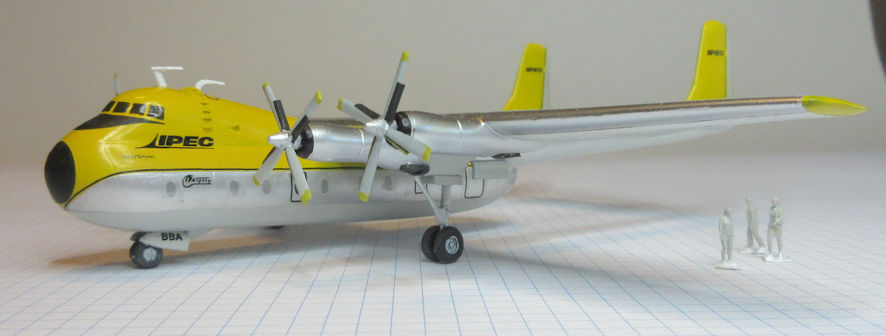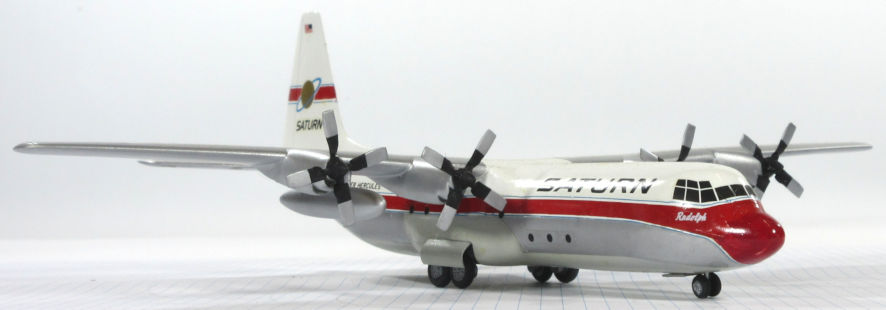Turboprop cargo aircraft
Transall 160 – Armstrong Whitworth Argosy Series 100 – Lockheed L-100

The turboprop engine is a variation on the jet engine in which the thrust generated by the gas turbine is converted into power that drives a propeller. It is an efficient power plant at speeds below about 725km hour and has several advantages over turbojet and piston engines. It has a good power to weight ratio, uses readily available jet fuel and the thrust of the propellers can be used for short take off and landing in reverse pitch. These features make turboprop engines very attractive for use in military cargo aircraft and the three we are looking at today are all civil versions of military cargo aircraft.
Transall 160 in 1/144 by F-Rsin
This aircraft was a joint French and German project to build a freighter to replace existing piston engines freight aircraft in service with the French and German air forces. Design began in 1959 with the formation of ‘Transporter-Allianz’, shortened to Transall. One prototype was built in each country and the first one flew in February 1963. Between 1965 and 1985 a total of 214 were produced, serving mainly with the French and German air forces, but also flying in Indonesia, South Africa and Swizerland. Four Transalls were converted for use by the French Postal Service and flown by Air France.
This model was made using the F-Rsin 1/144 resin kit, which is the only kit in that scale. There is a nice build review of it in The Modelling Man Cave. It was available in Luftwaffe, Armee de l’Air and two Aeropostale schemes. I say ‘was’ because it is no longer listed on the F-Rsin website and I couldn’t find in any of my usual seller sites. So if you want to make a Transall your best bet is the Heller 1/72 kit which is fairly nice. I made the 160G version which has all the lumps and bumps of an electronic warfare version, and you can read my Workbench Note on it. It is a much bigger aircraft than you imagine.
Armstrong Whitworth Argosy in 1/144 by Welsh Models
This aircraft was initially designed to meet a military specification but, as the design firmed up the focus was on an aircraft to meet civil needs. An interesting feature was the twin boom arrangement so that the fuselage could be opened at both ends for rapid loading and unloading. The prototype first flew in January 1959 and they were introduced to service in 1961. The Royal Air Force then became interested in the Argosy to replace its existing piston engined freighters and ordered a modified version which included a sealed nose and revised tail so that it could drop freight and paratroopers. The last Argosies were retied from air force service in 1978 and civil use in 1991.
This model was made using the Welsh Models 1/144 Welsh Models kit. When I made it also had the Micro Mir kit which was published in both the civil and military versions in 2017. Thee is a good write-up about it in Britmodeller. I chose to make the Welsh Models version because the Mikro Mir kit looks very complicated in the box whereas the Welsh Models kit doesn’t. As much as I like Welsh Models kits I think I might have made the wrong decision on this occasion. You can read my Workbench Note and see what you think.
Lockheed L-100-30 Hercules
This aircraft was a civil version of the famous Lockheed C-130E Hercules military transport. Lockheed decided to produce a de-militarized version of it. The first one flew in April 1964 and they began entering service in September 1965. It was not a great sales success so Lockheed offered two new versions, the L-100-20 that was 2.52 meters longer and the L-100-30 that was stretched by a further 2.03 meters. A total of 144 L-100s were manufactured between 1964 and 1992. Some military C-130s have also ended up in civil use.
I made this model using the Welsh Models 1/144 resin kit and I remember it as a very simple and pleasant build. Welsh Models offer this in all three versions, the L-100-10, -20 and -30. You might also be able to convert a C-130E into a L-100, the main difference probably being the fuselage length which you would have to calculate. According to Cybermodeler Online the Minicraft kit is pretty good.



